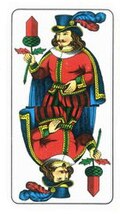Cards
Spitzeln is played with a pack of German-suited cards from which the 8 of Hearts and all the bells have been removed apart from the Seven of Bells, leaving 24 cards. The cards rank in their natural order: Deuce > King > Ober > Unter > Ten > Nine > Eight > Seven. [2]
The Ober of Acorns is the permanent top trump and is known as the Old Man (it corresponds to the Spadille in Ombre). The second-highest card is the trump Seven or Spitze. The Ober of Leaves is the third-highest (and corresponds to the Basta in Ombre). These three cards are matadors, as are any other cards of the trump suit that follow them consecutively. All matadors attract special bonuses. The suit of Bells ranks above the other suits and is called the couleur. [5] If trumps are not Bells, the Seven of Bells counts as a Deuce. Nevertheless, because there are no other cards in this suit, you have to ensure there are no trumps left before playing it otherwise it will be trumped. [2]
Playing
Player order and dealer are randomly determined. The dealer shuffles, offers the cut to rearhand and then deals eight cards, clockwise, to each player. Only Solo games are possible and, to win, the soloist has to take five tricks. Starting with the dealer's left, players announce whether they will play or pass. [2]
If the dealer plays, he antes four chips (Marken) to the pot (Pot) as a basic stake (Stamm); if not, he pays nothing, but after passing the next dealer must ante four chips. [2]
If all three players pass, the cards are thrown in and the next dealer takes over. [2]


